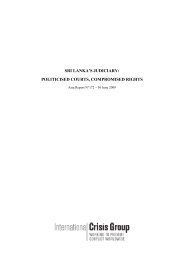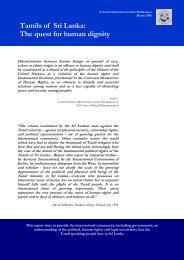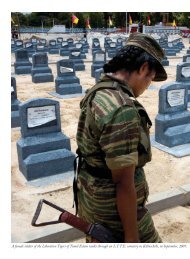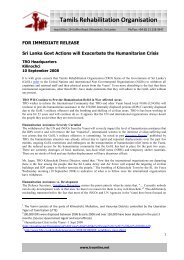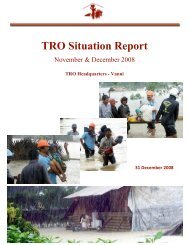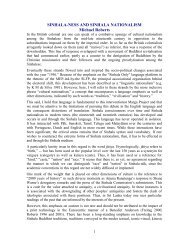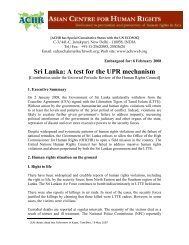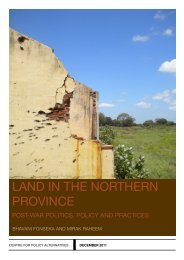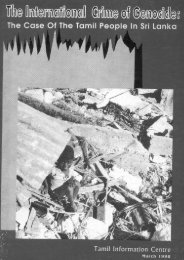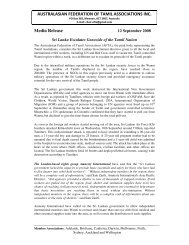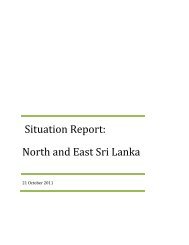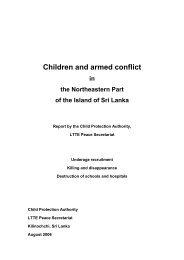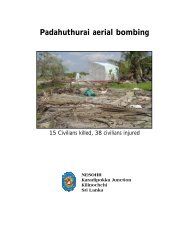The Conflict in Sri Lanka: Ground Realities - Ilankai Tamil Sangam
The Conflict in Sri Lanka: Ground Realities - Ilankai Tamil Sangam
The Conflict in Sri Lanka: Ground Realities - Ilankai Tamil Sangam
You also want an ePaper? Increase the reach of your titles
YUMPU automatically turns print PDFs into web optimized ePapers that Google loves.
4. Consequently the feel<strong>in</strong>g of a m<strong>in</strong>ority complex by the<br />
S<strong>in</strong>halese who not only see themselves as a few millions<br />
<strong>in</strong> an ocean of <strong>Tamil</strong>s <strong>in</strong> South India and <strong>in</strong> <strong>Sri</strong> <strong>Lanka</strong><br />
who can be overwhelmed by the language and published<br />
literature of the elites of the big neighbour In effect to the<br />
outside observer, <strong>Sri</strong> <strong>Lanka</strong> is an island <strong>in</strong>habited by two<br />
m<strong>in</strong>orities, two ethnic groups (S<strong>in</strong>halese and <strong>Tamil</strong>s) each<br />
seized with a m<strong>in</strong>ority complex.<br />
<strong>The</strong> Indian Factor<br />
Thus dur<strong>in</strong>g the period 1948 to the present the <strong>Tamil</strong>s under<br />
the leadership of the <strong>Tamil</strong> Federal Party were be<strong>in</strong>g k<strong>in</strong>dled by<br />
a burgeon<strong>in</strong>g <strong>Tamil</strong> nationalism <strong>in</strong> a quest for equal status with<br />
the S<strong>in</strong>hala Buddhist majority. <strong>The</strong> <strong>Tamil</strong>s quickly realised that<br />
with India’s <strong>in</strong>tervention <strong>in</strong> July 1987 the Indian government<br />
would not permit a separate sovereign state <strong>in</strong> their backyard<br />
which from Indian perceptions would not only become the<br />
happy hunt<strong>in</strong>g ground of foreign powers hostile to India such as<br />
Pakistan, Bangladesh and Ch<strong>in</strong>a. India was will<strong>in</strong>g to sponsor<br />
anyth<strong>in</strong>g short of an <strong>in</strong>dependent state. Hence the <strong>Sri</strong>. <strong>Lanka</strong>-<br />
India Accord of July 1987. Mr Rajiv Gandhi claimed that he<br />
had ensured that the <strong>Sri</strong> <strong>Lanka</strong>n <strong>Tamil</strong>s were be<strong>in</strong>g granted ‘the<br />
substance of Eelam’ without actual separate statehood.<br />
<strong>The</strong> Federal Initiative<br />
When federalism was <strong>in</strong>troduced by the <strong>Tamil</strong> leadership as a<br />
protest and disapproval of the unjust and <strong>in</strong>human parliamentary<br />
legalisations <strong>in</strong>troduced aga<strong>in</strong>st the <strong>Tamil</strong>s of Indian orig<strong>in</strong>, the<br />
concept was not so readily accepted for nearly three decades<br />
(1949-76) by the <strong>Tamil</strong> electors. Whereas the ideology of a<br />
separate state was more easily grasped because it was easier to<br />
comprehend; it ga<strong>in</strong>ed currency <strong>in</strong> a short span of three years<br />
--as it was a reversion to the past of the <strong>Tamil</strong> k<strong>in</strong>gdom and the<br />
<strong>Tamil</strong> k<strong>in</strong>gs.<br />
Thus from the year of the <strong>in</strong>auguration of the <strong>Tamil</strong> Federal<br />
Party to the launch<strong>in</strong>g of the Eelam Wars from 1983 onwards,<br />
federalism was not so much enthusiastically supported perhaps<br />
49



